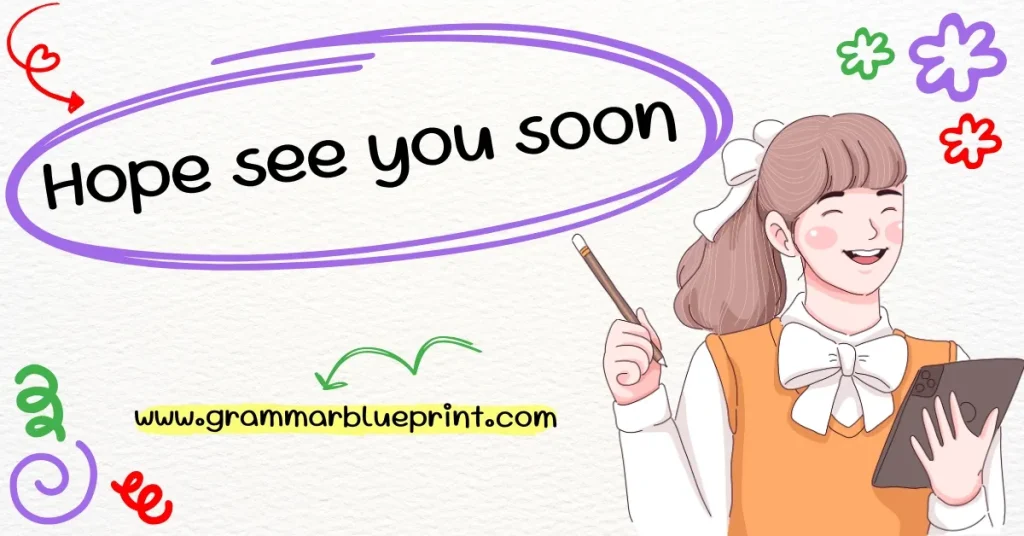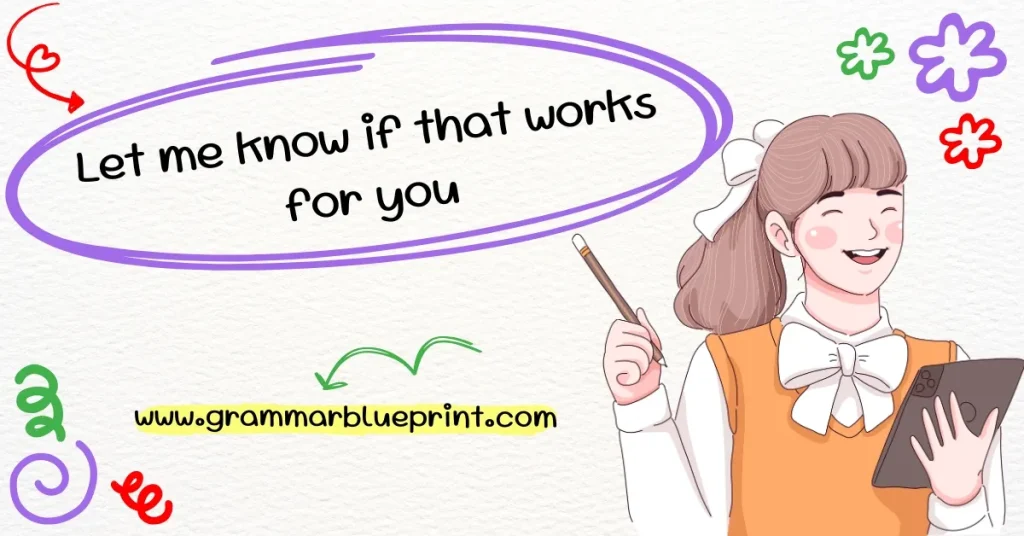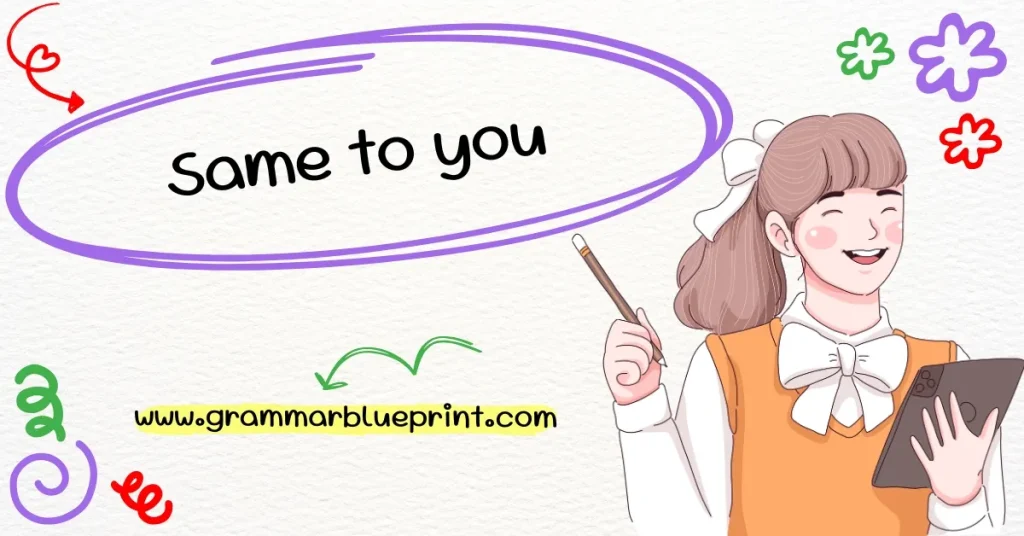The phrase “Hope to see you soon” is an essential part of casual and formal communication in English. It expresses a hopeful sentiment when parting ways, leaving the door open for future interaction. You will often hear it in both spoken and written English, making it a versatile expression in any English learner’s toolkit. But when exactly should you use it? And how can you properly incorporate this phrase into your conversations? Let’s dive into the details!
What is “Hope See You Soon”?
“Hope to see you soon” is a friendly, hopeful phrase used when parting ways with someone. It expresses a wish that you’ll reconnect in the near future, leaving a positive, open-ended feeling. This phrase is commonly used after a meeting, conversation, or social interaction, indicating that you look forward to seeing the person again.
In simple terms, it’s a polite and friendly way of saying goodbye while expressing the hope of meeting again soon. It’s widely used in both casual and more formal interactions, depending on the context and tone.
Correct Grammar for “Hope See You Soon”
While “Hope see you soon” is a commonly used phrase, there are some important grammar points to consider when using it properly.
Common Grammatical Errors with the Phrase
One frequent mistake is leaving out parts of the sentence that clarify the structure. The phrase should be, “I hope to see you soon,” not simply “Hope see you soon.”
Proper Structure: “I Hope to See You Soon”
The correct way to say this is “I hope to see you soon.” Here, “hope” is a verb, and “to see” is the infinitive form of the verb, which is required in this sentence structure.
Tips on Forming Similar Sentences with Proper Grammar
If you’re looking to use similar phrases, make sure you’re using the right verb forms. For example:
- I hope to talk to you soon
- I hope to hear from you soon
Both use the correct structure, with the verb “hope” followed by “to” and the infinitive verb.
When to Use “Hope See You Soon”
In Informal Settings
“Hope to see you soon” is perfect for casual conversations with friends, family, or colleagues. It’s often used when leaving a social event, hanging out with friends, or even after a friendly chat with a colleague. It signals that you had a good interaction and look forward to more.
With Friends, Family, and Colleagues
This phrase can be used with people you have a comfortable relationship with, such as friends, family members, and coworkers. It helps maintain positive connections and shows that you appreciate their company and are looking forward to future interactions.
After Meetings or Casual Conversations
After a meeting or casual conversation, you can say “Hope to see you soon” to leave the door open for future conversations. It can be a warm way of concluding a discussion while reinforcing a desire to stay in touch.
Differences Between Formal and Informal Uses
While “Hope to see you soon” is casual, it can still be used in formal contexts like professional emails or meetings. However, in more formal settings, you might want to adjust your tone or use alternatives to make it sound more polished.
Benefits of Using “Hope See You Soon” in Communication
Encouraging Positive Interactions
Using “Hope to see you soon” helps end a conversation on a positive note. It implies that you’ve enjoyed the interaction and look forward to meeting again, which can leave the other person with a pleasant impression.
Enhancing Politeness in Conversations
This phrase adds a level of politeness and courtesy to your interactions. It shows you care about continuing the relationship, whether personal or professional.
Strengthening Relationships Through Friendly and Hopeful Expressions
When you use “Hope to see you soon,” you signal that you value the relationship. It’s a simple but effective way of showing kindness and maintaining ongoing rapport with others.
How to Improve Fluency with Phrases Like “Hope See You Soon”
Practice in Daily Conversations
To truly internalize phrases like “Hope to see you soon,” try using them frequently in your everyday conversations. The more you say it, the more comfortable you’ll become with it.
Listen to Native Speakers and Repeat
One of the best ways to improve fluency is by listening to native speakers. Pay attention to how they use phrases like this in context, and practice mimicking their pronunciation and tone.
Use in Emails and Messages
Incorporating “Hope to see you soon” in your emails or text messages adds a friendly, personal touch. It’s an excellent way to keep your written communication warm and polite.
Role-playing Exercises for Fluency
Role-playing is another fantastic way to practice. Create scenarios where you’re saying goodbye to someone in both formal and informal settings and use the phrase appropriately.
Mistaking “Hope” for Other Similar Verbs
One mistake learners make is confusing “hope” with similar verbs like “wish” or “want.” While these words are related, they are used differently in sentences. For example:
- “I wish to see you soon” sounds more like a desire rather than a hopeful expression.
- “I want to see you soon” is more direct and doesn’t carry the same polite tone as “hope.”
Misplacing Word Order
Another common mistake is the improper word order. Instead of “I hope to see you soon,” some learners might say, “Hope I see you soon,” which is less grammatically correct. Always include the subject “I” and the infinitive verb “to see.”
Overuse of the Phrase
While it’s a nice phrase, using “Hope to see you soon” too often can make it feel less sincere. Be sure to vary your goodbyes depending on the context and your relationship with the person.
Better Alternatives to Say “Hope See You Soon”
Below are some alternatives to the phrase “Hope to see you soon,” which you can use to keep your goodbyes fresh and varied.
1. Looking Forward to Seeing You
- Meaning: Expresses excitement and anticipation about a future meeting.
- Best Use: Ideal for both casual and semi-formal situations.
- Tone: Friendly, positive, and warm.
2. Can’t Wait to See You
- Meaning: A more enthusiastic way to express eagerness.
- Best Use: Perfect for close friends or family members.
- Tone: Casual, eager, and excited.
3. See You Soon
- Meaning: A straightforward, neutral way to say goodbye.
- Best Use: Suitable for informal settings with friends or colleagues.
- Tone: Simple and friendly.
4. Talk to You Soon
- Meaning: Implies that the conversation will continue soon.
- Best Use: Common in professional or friendly contexts.
- Tone: Casual but polite.
5. Catch You Later
- Meaning: A laid-back way to say goodbye, often used with friends.
- Best Use: Informal conversations.
- Tone: Relaxed, friendly.
6. Till Next Time
- Meaning: A way of saying goodbye with the expectation of meeting again.
- Best Use: Works well with friends and colleagues.
- Tone: Casual, hopeful.
7. Take Care Until We Meet Again
- Meaning: A more thoughtful, considerate goodbye.
- Best Use: Often used in both personal and semi-formal contexts.
- Tone: Warm and caring.
8. Hope to Catch Up Soon
- Meaning: Suggests a desire to reconnect and have a conversation later.
- Best Use: When leaving a conversation with the intent to continue it.
- Tone: Friendly and inviting.
9. Until Next Time
- Meaning: Similar to “Till next time,” it implies a hopeful meeting again in the future.
- Best Use: Works well with casual acquaintances, friends, or colleagues.
- Tone: Warm and informal.
10. See You Around
- Meaning: A casual way to say goodbye with the expectation of seeing the person again at some point.
- Best Use: Informal settings, often with acquaintances or friends.
- Tone: Easy-going and casual.
11. Take It Easy
- Meaning: A laid-back farewell suggesting relaxation and good vibes.
- Best Use: Informal conversations, especially with friends.
- Tone: Chill, friendly.
12. Catch You On the Flip Side
- Meaning: A playful and informal way to say goodbye.
- Best Use: Best for close friends or casual settings.
- Tone: Playful, informal.
13. Stay Safe
- Meaning: A caring way to say goodbye with the intention of someone staying well and healthy.
- Best Use: Personal and semi-formal settings.
- Tone: Caring, thoughtful.
14. See You Later, Alligator
- Meaning: A fun, rhyming phrase often used in casual and playful contexts.
- Best Use: For friends, children, or fun environments.
- Tone: Lighthearted, playful.
15. Be Seeing You
- Meaning: A less common but still friendly way to say goodbye.
- Best Use: Mostly casual conversations.
- Tone: Casual, somewhat informal.
16. Until We Meet Again
- Meaning: A more poetic, thoughtful goodbye.
- Best Use: Personal, semi-formal, or heartfelt conversations.
- Tone: Warm, sincere.
17. Don’t Be a Stranger
- Meaning: A friendly way of saying goodbye, encouraging someone to stay in touch.
- Best Use: Casual or semi-formal conversations, with friends or colleagues.
- Tone: Friendly, encouraging.
18. I’ll Be Seeing You
- Meaning: Implies a future meeting or continuation of the relationship.
- Best Use: Used with friends or people you plan to see again soon.
- Tone: Slightly more informal, nostalgic.
19. Take Care of Yourself
- Meaning: A thoughtful and caring way to say goodbye.
- Best Use: Personal settings, especially when showing concern for someone.
- Tone: Caring, warm.
20. See You in the Future
- Meaning: A way to express that you hope to see the person again at some point in time.
- Best Use: When you’re uncertain about when you’ll meet again but want to keep the door open.
- Tone: Neutral, optimistic.
21. See You Soonish
- Meaning: A more playful way of saying “soon,” with a little less certainty about the timing.
- Best Use: Casual settings, with friends.
- Tone: Playful, informal.
22. Looking Forward to Our Next Conversation
- Meaning: Indicates you anticipate talking again soon.
- Best Use: Professional, academic, or semi-formal settings.
- Tone: Formal, polite, enthusiastic.
23. It Was Great Seeing You
- Meaning: A way to express that you enjoyed the meeting and look forward to the next one.
- Best Use: Casual to semi-formal settings.
- Tone: Positive, warm.
24. Till We Meet Again
- Meaning: Similar to “Until we meet again,” but typically more common in more formal settings.
- Best Use: Formal or semi-formal conversations.
- Tone: Respectful, hopeful.
25. Looking Forward to Catching Up
- Meaning: Suggests an eagerness to have another chat or update in the future.
- Best Use: Professional or casual conversations where you want to continue the discussion.
- Tone: Friendly, enthusiastic.
26. Enjoy the Rest of Your Day
- Meaning: A polite way to end a conversation while wishing someone well for the rest of their day.
- Best Use: Often used in semi-formal settings or at the end of an interaction.
- Tone: Polite, considerate.
27. Let’s Do This Again Soon
- Meaning: A way of expressing that you enjoyed the interaction and hope to do it again soon.
- Best Use: Casual conversations, when you want to show you value the connection.
- Tone: Friendly, casual.
28. Wishing You the Best Until Then
- Meaning: A thoughtful and well-wishing goodbye.
- Best Use: Personal settings or semi-formal situations.
- Tone: Warm, considerate.
29. Until Our Paths Cross Again
- Meaning: A poetic way to say goodbye, often used when you’re not sure when you’ll meet again.
- Best Use: Used in formal or semi-formal settings.
- Tone: Formal, poetic.
30. Farewell for Now
- Meaning: A gentle way to say goodbye with the hope of meeting again in the near future.
- Best Use: Semi-formal or formal situations.
- Tone: Elegant, polite.
With these 30 alternatives, you’ll never be short of ways to say goodbye! Each one brings a distinct nuance to the conversation, so you can choose based on the tone and formality of the situation.
How Different Cultures May Express Goodbyes
The way people say goodbye varies greatly from culture to culture. While “Hope to see you soon” is common in English-speaking countries, other languages may have their own expressions with different connotations or usages.
When to Avoid Using This Phrase in Formal Contexts
In formal settings, especially with people you don’t know well, it’s better to use more neutral phrases like “I look forward to meeting with you again” or “I look forward to our next meeting.” These are more suitable for business environments.
Regional Variations in Similar Expressions
In the U.S., “See you later” is a popular informal goodbye, while in the UK, you might hear “Cheerio” or “Ta-ta,” which offer the same casual tone.
Conclusion
“Hope to see you soon” is a simple, effective phrase that can enhance your English communication. Whether you’re chatting with friends, wrapping up a business meeting, or writing a polite email, knowing when and how to use this phrase is essential. And by exploring alternatives, you’ll have a wide range of options to sound natural and maintain positive relationships in English. Keep practicing, and soon you’ll be using these expressions with confidence and ease!



